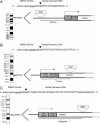An infectious retrovirus susceptible to an IFN antiviral pathway from human prostate tumors
- PMID: 17234809
- PMCID: PMC1776164
- DOI: 10.1073/pnas.0610291104
An infectious retrovirus susceptible to an IFN antiviral pathway from human prostate tumors
Abstract
We recently reported identification of a previously undescribed gammaretrovirus genome, xenotropic murine leukemia virus-related virus (XMRV), in prostate cancer tissue from patients homozygous for a reduced activity variant of the antiviral enzyme RNase L. Here we constructed a full-length XMRV genome from prostate tissue RNA and showed that the molecular viral clone is replication-competent. XMRV replication in the prostate cancer cell line DU145 was sensitive to inhibition by IFN-beta. However, LNCaP prostate cancer cells, which are deficient in JAK1 and RNase L, were resistant to the effects of IFN-beta against XMRV. Furthermore, DU145 cells rendered deficient in RNase L with siRNA were partially resistant to IFN inhibition of XMRV. Expression in hamster cells of the xenotropic and polytropic retrovirus receptor 1 allowed these cells to be infected by XMRV. XMRV provirus integration sites were mapped in DNA isolated from human prostate tumor tissue to genes for two transcription factors (NFATc3 and CREB5) and to a gene encoding a suppressor of androgen receptor transactivation (APPBP2/PAT1/ARA67). Our studies demonstrate that XMRV is a virus that has infected humans and is susceptible to inhibition by IFN and its downstream effector, RNase L.
Conflict of interest statement
The authors declare no conflict of interest.
Figures





Comment in
-
A new human retrovirus associated with prostate cancer.Proc Natl Acad Sci U S A. 2007 Jan 30;104(5):1449-50. doi: 10.1073/pnas.0610912104. Epub 2007 Jan 23. Proc Natl Acad Sci U S A. 2007. PMID: 17244700 Free PMC article. No abstract available.
References
-
- Goff S. In: Fields Virology. Knipe DM, Howley PM, editors. New York: Lippincott Williams & Wilkins; 2001. pp. 1871–1939.
-
- Bartosch B, Weiss RA, Takeuchi Y. J Gen Virol. 2002;83:2231–2240. - PubMed
-
- Carter BS, Bova GS, Beaty TH, Steinberg GD, Childs B, Isaacs WB, Walsh PC. J Urol. 1993;150:797–802. - PubMed
Publication types
MeSH terms
Substances
Associated data
- Actions
Grants and funding
LinkOut - more resources
Full Text Sources
Other Literature Sources
Medical
Research Materials
Miscellaneous

